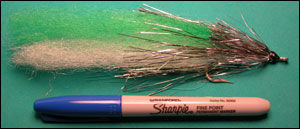(Editor’s note: Dick Smith is a long-time board member of SWMTU and avid fisherman. This article first appeared in Trout Talk.)
By Dick Smith
The Grand River is famous for its big pike, but they are generally caught by accident by someone who is fishing for something else.
Pike are very specialized predators. They hunt from ambush. Their large anal and dorsal fins are set well back near their tails. Those fins act as vertical stabilizers, but those two large fins also act in combination with the tail to accelerate the fish from motionless to top speed in only a few
quick beats. Pike have incredible acceleration in a straight line, and if a pike can get its nose pointed at a prey fish that is reasonably close, that fish has almost no chance at all of surviving. But pike have very little maneuverability, and if the prey fish can stay to the side of a pike or behind it, the fish is fairly safe.
Pike feed most efficiently on other fish that are about one-third the pike’s length and one-fifth its weight. So large pike like large minnows. The best of the pike flies I have used is tied like this.
 Hook- 3/0 heavy wire. I use saltwater hooks.
Hook- 3/0 heavy wire. I use saltwater hooks.
Tail- white Enrico Puglisi fibers six or seven inches long topped by an equal amount of emerald green fibers the same length. The tail is really the wing, tied in at the back of the fly to keep the soft material from fouling on the hook.
Body- silver mylar tubing wrapped like tinsel.
Throat- silver flashabou extending back three or four inches.
Wing- more silver flashabou if you want it.
The largest king salmon I ever caught took one of those pike streamers. I
was standing on a high bank above a bend in the Pere Marquette river and I watched a big fish rampage around the pool below me. He chased everything that came near him. He was able to maneuver around enough in that deep water so he got a hold of a much smaller male that got too close to him. The smaller fish was about seven pounds. The big one got the smaller fish across the middle of the back and he shook it like a dog shakes a rat. When he let that fish go it went to the bottom on its side, and died there. He was chasing another salmon around when I went down and made my first cast. As the big fly swung down toward him the fish came at least ten feet to attack it. I had changed to a 16 pound test tippet and I still had a long chase downstream before I got him on his side in the shallows.
Pike in big rivers prefer slow, almost still, water and wherever there is a small bayou, large pike will hunt along the entrance to the bayou. Wherever there is a slowly turning eddy on the outside of a bend, pike like to hunt the edge of the flat on the upstream side and close to the shore in the still water along the eddy. The water of the Grand River tends to be slightly clearer where it is very slow and drops some of its silt load, and those areas are better for fly fishermen. Pike live very
far into the arctic. They like cold water and in the summer they seek it out. They will be in the still water below where a cold creek flows into the river, and that tends to be fairly clear water too.
I have been cut off twice by very large pike. At first I used a leader of five feet of straight sixty pound test. I watched a huge fish take my fly and cut it off easily. I added a six inch wire leader to the six feet of sixty pound test, and that worked pretty well. I landed some nice fish with that set up, before I got cut off on the strike by a fish I never saw. The leader I now use for pike is four feet of sixty pound test (.023), two feet of twenty pound test Fireline, and an eight inch, eighteen pound test wire leader. It is necessary to tie Palomar knots in Fireline, so I tie the Fireline to the wire leader and I tie a swivel to the other end of the line. I make up several of those leaders ahead of time and tie the swivel to the sixty pound butt when I‚m ready to fish.


Leave a Reply